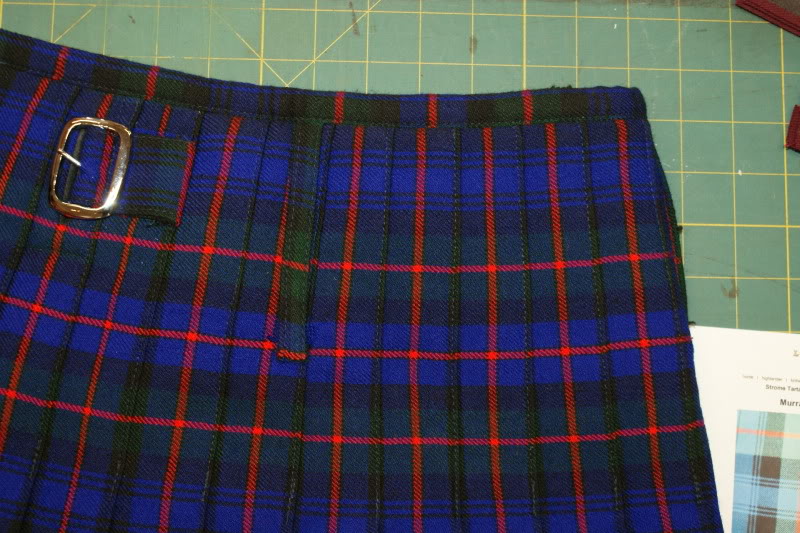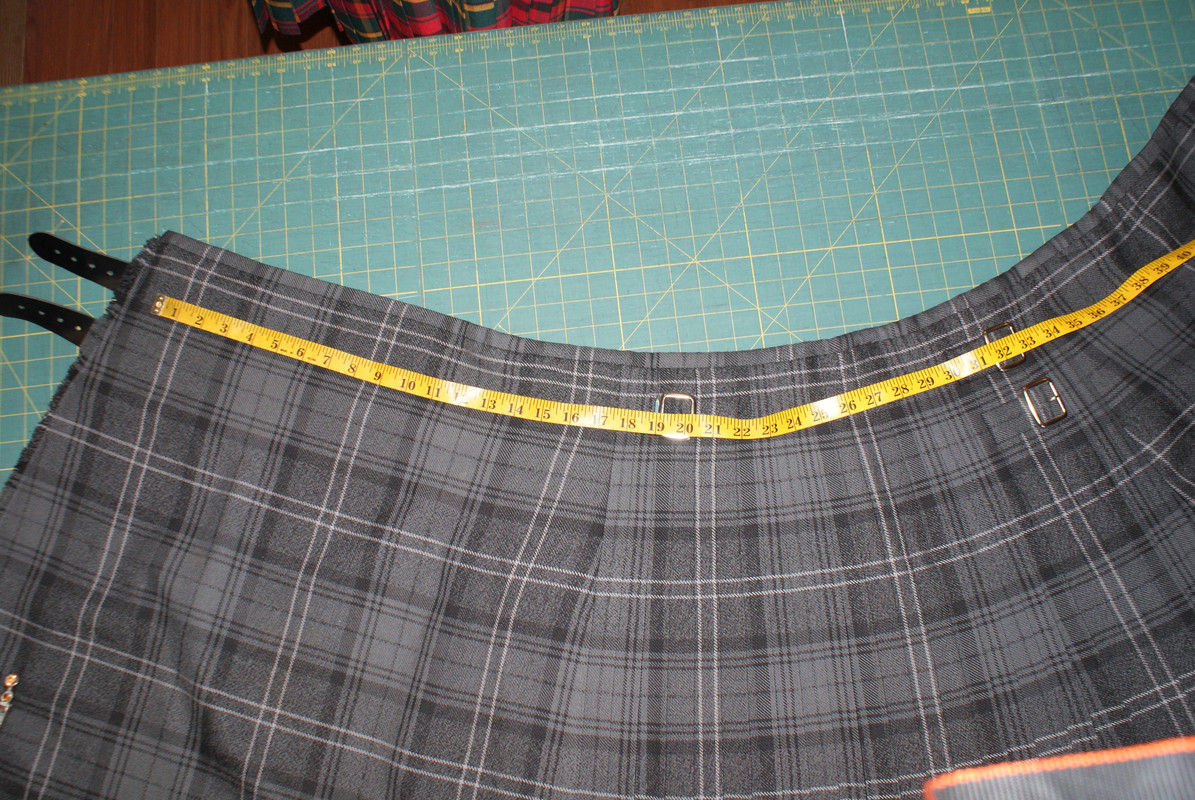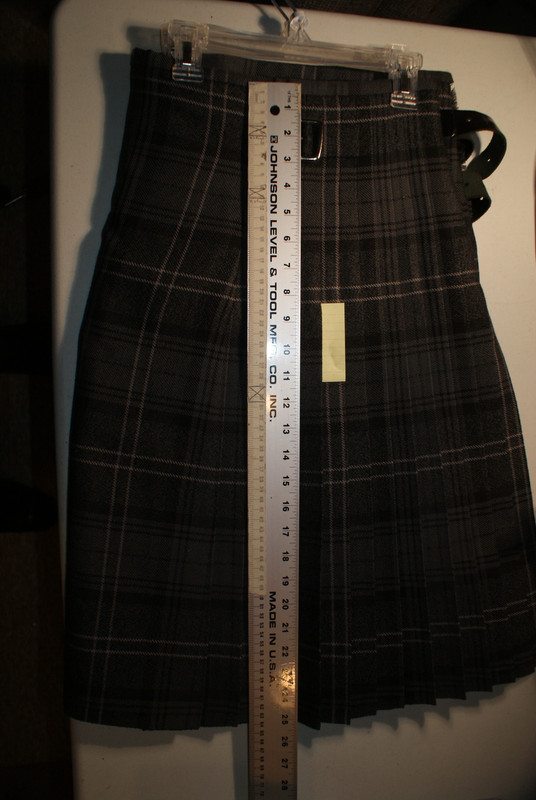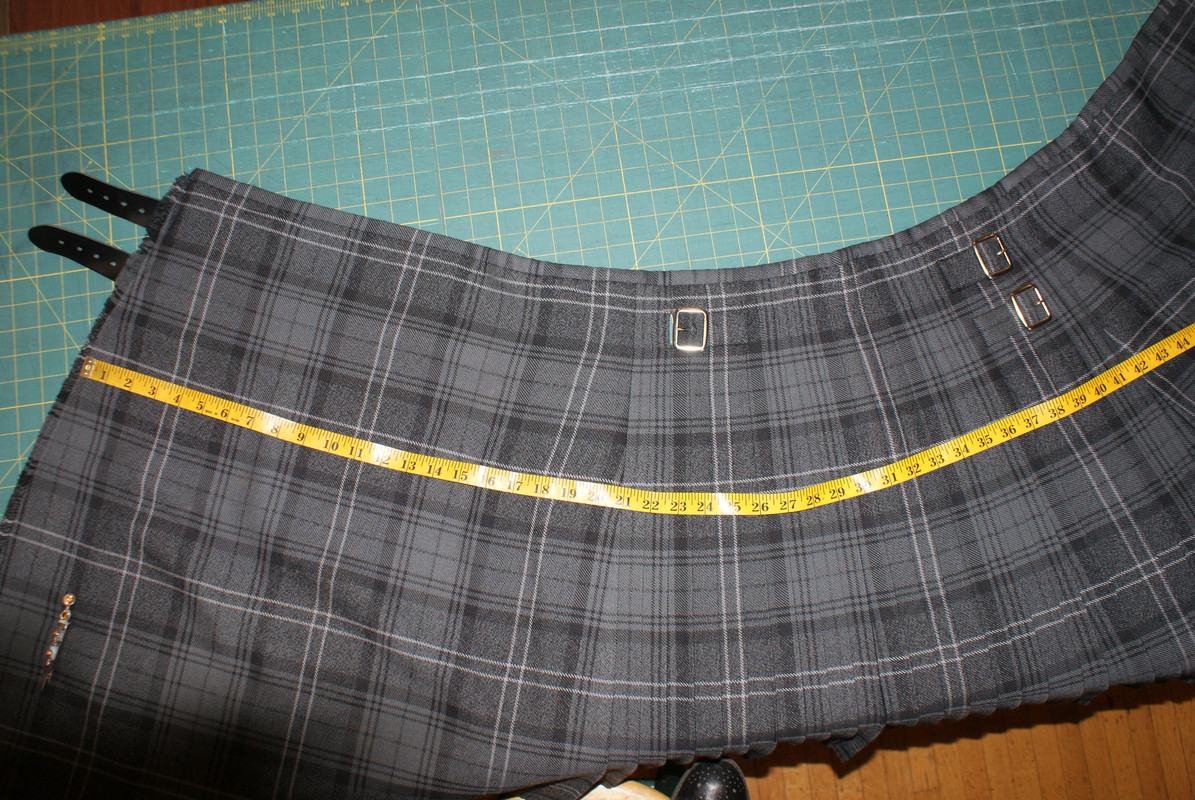|
-
8th November 13, 05:17 PM
#1
Is my kilt the size I think it is?
We hear on X Marks all the time about a guy who orders a kilt and when it arrives it does not fit.
What is wrong?
I thought I would do a tutorial on how to tell if the kilt you got, is the size that you ordered.
Now, before I get too far into this perhaps I should re-enforce the idea that communication is the most important part of ordering a new kilt.
I suggest that you communicate directly with the person who will actually stitch your kilt. Sometimes, if your trying to save a few bucks and ordering from a large company who does not actually make their own kilts, talking to the kiltmaker may not be possible.
But please communicate. Three or four emails back and forth before you place your order will usually save a lot of frustration later on.
The second most important thing is taking good measurements. Did you take your measurements right?
I cannot stress strongly enough that you must take your measurements using the measuring instructions of the person who will make your kilt.
Never, ever, send in a set of measurements to one kiltmaker using the measurements you got from another kiltmaker or off of another kiltmakers site or from a youtube video!
There is one part of the measuring that always seems to bring up the same problems. The location of where the Waist of the kilt, is designed by the maker, to fit.
One of the hallmarks of kilts that are made in the Traditional style is that they are designed to be worn at the anatomical waist. If you order a kilt that is made in the traditional manner, then attempt to wear it at anything other than where it was designed to be worn, it will not fit, look or swish the way it was designed to.
You may wish to wear your kilt lower, but a kilt designed to be worn at the anatomical waist, will not fit or look right if worn where it was not designed to be worn.
We see this all over the web. The hem is down below the top of the knee cap because the kilt is being worn lower that it was designed. This is also the cause of large shower curtain folds in the back pleats or the kilt having splayed, distorted or a distinct "A-line skirt" shape.
So, where is the anatomical waist.
Here is a photo showing how the anatomical waist differs from where we wear pants.
The top band is at the anatomical waist.
For reference, the navel in this photo is in the center of the center band.
(Traditional kiltmakers do not use the navel as a reference because the navel is in soft tissue and changes. The more of a belly you have, the lower the navel will be. If the measuring system of where you wish to purchase your kilt, references the navel, it is a very good chance that they make kilts in something other than the Traditional method. This is not bad, you just need to know this before you order.)
 
If you wish to wear your kilt at something other than the Traditional anatomical waist, that is great. Just make sure you order your kilt from a maker who is familiar the type of kilt you want to wear.
And this confuses the issue because not everyone understands that not all kilts are made the same. I think you can all understand, that if you want your kilt to stay put on your body the kilt should be made with the smallest part of the kilt at the top buckles. That only makes sense, right?
Well, here is a kilt sold by a well known Scottish company. Take a look at where the smallest part of the kilt is. It is at the top of the kilt, not at the level of the top straps.
This kilt will always slide down until the smallest part of the kilt fits into the smallest part of your body.


Here is a kilt with the smallest part of the kilt at the top straps. Can you see the difference?


The lesson here is that you must know what type of kilt the kiltmaker makes. This brings us back to communicating with your kiltmaker.
Now, your kilt has arrived and when you strap it on it does not fit. What now?
Well, three things may have happened. You may have sent the wrong measurements. Or, the kilt is not made to the measurements you sent in. Or the kilt is not made in the style you thought it was.
How do you tell?
First let's look at the length of the kilt.
If your kilt is made in the Traditional way, like the gray kilt above, the "Drop" measurement is taken from the center of the top straps down to the hem.
The part of the kilt above the top straps is called the "Rise". A hint - if the measuring instructions or the description of the kilt do not mention "Rise" the maker may not make kilts in the Traditional style.
In this photo I have put a yardstick with "0" at the center of the top buckle.

You can see the yellow tape measure showing the 2" rise above the buckle.
This kilt has a drop of 23" and a rise of 2" for a total length of 25".

If you sent your kiltmaker the 25" measurement but they assumed from their instructions that you meant Drop you will now have a kilt that is too long.
Remember what I said about communicating with your kiltmaker? It is really a good idea to know what definition of terms the kiltmaker will use when they start sewing.
Last edited by Steve Ashton; 9th July 21 at 04:37 PM.
-
The Following User Says 'Aye' to Steve Ashton For This Useful Post:
-
8th November 13, 05:25 PM
#2
Ok, let's move on to the waist circumference measurement. How do you find out what the waist size of a kilt is?
When you put a kilt on, the outer apron overlaps the under apron. We all know that. But how much?
Well, that is a good question. And again we need to talk to our kiltmaker before we order.
Here is the front apron of a traditional style kilt.
I need you to look closely at the Tartan pattern in this kilt apron.


Can you see that the double white lines appear to be at the center of the apron?
Can you also see that the fringed edge of the apron is different from the non-fringed edge?
Well, on a kilt made in this Traditional manner the outer apron is designed to overlap the under apron by 1".
Again, not all kilts are made the same. It is very common today not to have this extra inch added when laying out the aprons. I have not, in recent years, seen a Scottish made kilt made with this 1" of extra even though this is the traditional way to do it.
You don't need to know this when you are measuring to send in your kilt order. You don't even need to know this when you wear the kilt.
The only time you need to know this is when you are measuring a kilt on the table.
OK, take your your tape measure and let's find out what the waist size of this kilt is.

Start at the fringed edge of the outer apron aligned with the top strap on a traditional kilt with the flare to the Rise above the top strap. If the kilt you have does not have the flare you will measure at the smallest part of the kilt.
Now, carefully measure across the kilt At the level of the top straps and buckles on a Traditionally made kilt - from the edge of the outer apron - all the way over to the right edge of the under apron. (Do not measure the under apron.)
(If your kilt has the extra 1" start measuring 1" in from the fringe.)

The idea here is quite simple but it is interesting how many people don't think about it.
The outer apron wraps around and overlaps the under apron. The waist measurement of a kilt is then - from the right edge of one apron all the way across to the right edge of the other apron.
On the kilt in this example the waist measurement is 34".
Last edited by Steve Ashton; 9th July 21 at 04:39 PM.
-
The Following User Says 'Aye' to Steve Ashton For This Useful Post:
-
8th November 13, 05:47 PM
#3
What about the hips?
One of the easiest way to tell if the Hip size of your kilt is correct is to put on the kilt and look in a mirror.
If the hip measurement of your kilt is too big you may see some "shower curtain" like waves or folds in the back of your kilt.
If the hip measurement of your kilt is too small the aprons will not overlap properly.
So let's go back to the gray kilt and find out what the hip measurement is.
Just as when we looked at the drop and the waist, finding out the hip size is a little more complex than at first glance.
Does everyone here understand what the word Fell means?
Simply put, the Fell Area of a kilt is the part in the back where the pleats are tapered and sewn down.
A traditional kilt is made with the length of the Fell about 1/3 the length of the total length of the kilt.
This is the Drop length + the Rise length.
In this photo you can see the ruler with "0" at the top of the kilt and a sticky note showing the bottom of the Fell area.


The total length of this kilt is 25".
The length of the Fell is 8.33"
All you need to do is stretch your tape measure along the kilt just as you did to measure the waist but now down equal to the bottom of the Fell area.


The Hip measurement of this kilt is 42".
Last edited by Steve Ashton; 9th July 21 at 04:40 PM.
-
The Following User Says 'Aye' to Steve Ashton For This Useful Post:
-
8th November 13, 06:00 PM
#4
Thank you for this very informative and important essay.
-
-
8th November 13, 06:06 PM
#5
I hope you found this helpful.
Let me re-cap just a few points.
Communicate, communicate, communicate.
If you really want to avoid problems, want to avoid the expense of sending a kilt back to be remade, and want to avoid the disappointment of a kilt that does not fit, communicate with your kiltmaker.
If you are buying your kilt on-line this communication becomes doubly important. If you are buying from one of the larger retail outlets that does not make their own kilts it become triply important.
(And it is amazing how many retailers you can find on line that sub-contract their kilts. Even I have been approached by some of these companies to do sub-contract work. If there is a question ask before you put down your hard earned money.)
Take good measurements first.
Read the instructions from the place you will order your kilt from. Follow those instructions to the letter. Just because you may think you know what your measurements are they may be different using the instructions from this kiltmaker.
A kiltmaker using the Traditional method will ask for three measurements. Waist circumference - Hip or breech circumference - and the Drop. (But remember that the Drop is different from the total length of the kilt to a Traditional kiltmaker.)
Just because the measuring system of the maker asks for the same 3 measurements does not guarantee that the kilt is made in the Traditional manner.
Know what type of kilt your kiltmaker makes.
Ask them if their kilt is designed to be worn at the anatomical waist or somewhere else.
Ask them if their Drop is the total length of the kilt or Drop + Rise. Ask if the Rise has flare.
Ask them if the Fell is 1/3 the length or something different.
For example -
This kilt is designed to be worn at the anatomical waist but the wearer is wearing it lower than it was designed to be worn. This is perhaps the most common thing you will see today. A garment designed to be worn at the anatomical waist being worn down where pants fit today.

Notice please that the bottom of the Fell Area is well below the line of the hips causing the shower curtain folds.. Notice also the popped stitches in the Fell of this kilt. This is caused by the wearer sitting on the part that is stitched which puts undue stress on the stitching.
Before you get all hot and upset over a kilt that arrived that does not fit. Before you write the kiltmaker saying that they made the kilt wrong, take the time to use this tutorial to insure that the kilt was made to the measurements you sent in. And that you are wearing the kilt they way it was designed to be worn.
Last edited by Steve Ashton; 9th July 21 at 04:44 PM.
-
-
8th November 13, 06:22 PM
#6
Outstanding post, Steve. Thanks for this.
KEN CORMACK
Clan Buchanan
U.S. Coast Guard, Retired
Cuyahoga Falls, Ohio, USA
-
The Following User Says 'Aye' to unixken For This Useful Post:
-
8th November 13, 06:49 PM
#7
By the way, and before everyone asks, the gray kilt in the photos is my personal Tewksbury. You can see this kilt on page 183 of the second printing of "The Art of Kiltmaking".
The Tartan is Highland Granite. Woven in 16oz wool by Lochcarron. This may be the first kilt ever made in the Highland Granite Tartan.
And please notice the length. The kilts I make for myself to be worn at mid-rise are 23" in total length. My traditional kilt designed to be worn at full-rise are 25" long. I am exactly 6' tall.
-
-
8th November 13, 11:58 PM
#8
Steve, this thread should be a Sticky. That way it can be a good reference for those needing help in this area.
Hawk
Shawnee / Anishinabe and Clan Colquhoun
-
The Following 4 Users say 'Aye' to Hawk For This Useful Post:
-
9th November 13, 02:44 PM
#9
Hi Steve,
Probably one of the best instructionals I've ever read on the kilts. Definitely needs to be a sticky.
Leaves no real excuses for ordering a badly fitting kilt...
Martin.
AKA - The Scouter in a Kilt.
Proud, but homesick, son of Skye.
Member of the Clan MacLeod Society (Scotland)
-
-
9th November 13, 03:11 PM
#10
Steve, thanks for this very informative post. Even those of us who have been wearing kilts for many years can do with a little refresher course on the how's and why's of the way our kilts are constructed.
His Exalted Highness Duke Standard the Pertinacious of Chalmondley by St Peasoup
Member Order of the Dandelion
Per Electum - Non consanguinitam
-
 Posting Permissions
Posting Permissions
- You may not post new threads
- You may not post replies
- You may not post attachments
- You may not edit your posts
-
Forum Rules
|
|




































Bookmarks